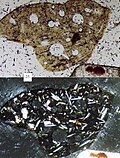Clastic rock

Clastic rocks are composed of fragments, or clasts, of pre-existing rock.
Although, in principle, almost any rock made of eroded former rock is clastic (such as sandstone or mudstone), in practice the term is used for clasts of at least gravel size upwards. That means clasts are at least visible to the naked eye, and may be huge.
There are two types of clastic rock, by shape. conglomerates have rounded clasts, and breccias have jagged clasts.[1]
In a clastic rock, the clasts are often of a different make-up from the ground rock or matrix.
Clastic Rock Media
A thin section of a clast (sand grain), derived from a basalt scoria. Vesicles (air bubbles) can be seen throughout the clast. Plane-polarized light above, cross-polarized light below. Scale box is 0.25 mm.
Basalt breccia, green groundmass is composed of epidote
References
- ↑ Neuendorf, Klaus; Mehl, James; Jackson, Julia 2005. Glossary of Geology. 5th ed, American Geological Institute: Alexandria, VA.
+{{{1}}}−{{{2}}}






